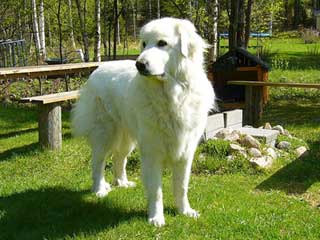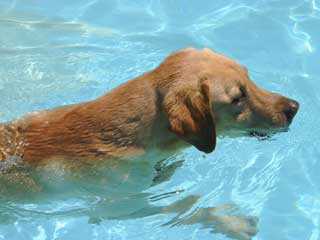| Grooming: |  |  |  |  |  |  |
| Shedding: |  |  |  |  |  |  |
| Energy Level: |  |  |  |  |  |  |
| Protection: |  |  |  |  |  |  |
| Watch Dog: |  |  |  |  |  |  |
| Group: | Working |
| Size: | Large |
| Life Span: | 8-10 years |
| Height: | Male: 27-32 inches |
| Female: 25-29 inches | |
| Weight: | Male: 100-130 lbs |
| Female: 85-110 lbs |
Great Pyrenees Facts
| Coat : | Outercoat is dense, flat and rough. Undercoat is dense and wooly |
| Gait : | Smooth and elegant |
| Color(s) : | Pure White or white with markings of gray, badger, reddish brown or different shades of tan. |
| Living Area : | Large |
| Hair Length: | Long |
| Exercise Need : | Daily long walk |
| Recognized By : |
(CKC) Canadian Kennel Club (FCI) F�d�ration Cynologique Internationale (AKC) American Kennel Club (UKC) United Kennel Club (KCGB) Kennel Club of Great Britain (CKC) Canadian Kennel Club (ANKC) Australian National Kennel Council (NKC) National Kennel Club (NZKC) New Zealand Kennel Club (APRI) America Pet Registry, Inc. (ACR) American Canine Registry (DRA) Dog Registry of America |
| Date of Origin : | Ancient |
| Place of Origin : | Siberia |
| Todays Use : | Companion Dog, Guard Dog |
| Originally Used : | Livestock Guardian Dog |
| Other Name : | Chien Des Pyrenees |
Great Pyrenees Information
Great Pyrenees Description:The origin of the Great Pyrenees lies in Siberia or parts of Central Asia. The ancestry of the breed lies in the Kuvasz and Maremmano Abruzesse. It is also believed that it is related in some way to St. Bernard. Prior to the 16th century, the breed inhabited high mountainous regions. However, by the starting of the 16th century, the breed became very popular with the noble class of France. Back then, it was used as a guard dog in France as well as protecting sheep from animals such wolves and bears. The breed was first recognized by the AKC in 1933. |
Great Pyrenees Care & Grooming:The Great Pyrenees sheds little throughout the year and heavily once in a year. Its long and dense double coat needs extensive grooming. Brushing of the coat at least 3-4 times a week is necessary to maintain a healthy looking coat. Daily brushing is required during the shedding season. Caution is advised against trimming the coat in hot weather since the breed is prone to sunburn. It should be bathed only when absolutely necessary and must be dried properly after each bath. The hair around its eyes, ears and paws should be trimmed regularly. |
Great Pyrenees Health Problems:The Great Pyrenees is prone to some health issues like Bloat, hip Dysplasia, Skin diseases, Cancer, Patellar luxation etc. |
| Group: | Herding |
| Size: | Small |
| Life Span: | 12-15 years |
| Height: | Male: 12-14 inches Female: 11-13 inches |
| Weight: | Male:30-35 lbs Female: 25-30 lbs |
| Color: | Various shades of grey and red |
| Description: | The origin of the Swedish Vallhund is uncertain. It is believed to be about 1,000 years ..... |












